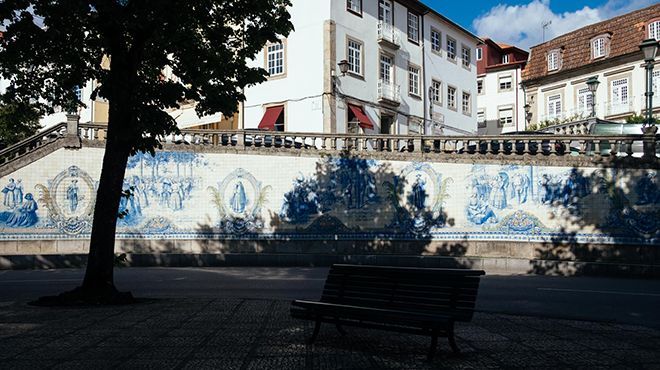In Viseu, from the Rossio to the Largo de São Miguel

In Viseu, from the Rossio to the Largo de São Miguel
Other
Rua Formosa begins in the Rossio, and intersects first with the Rua do Comércio and further along with the Rua Direita, which is the city's longest street and one of its oldest. The street is bordered by several 15th century houses, with significant details, including large doors, Coats of Arms, Manueline windows and doors that endow a special charm to this stroll through the noble city of Viseu.
In the Rua dos Andrades, to our right, between nos. 23 to 31 we can see a magnificent example of a Portuguese baroque palace bearing a coat of arms, dating from the first half of the 18th century -- the manor house of the Counts of Prime -- bearing the coat of arms of the Teixeira de Carvalho family. Returning to Rua Direita we proceed until the Largo Mouzinho de Albuquerque, where we encounter the Church of Santo António, that contains an extremely rich collection of 18th century azulejo tiles and a fine golden woodcarved altarpieces.
Visitors should also note the Casa do Arco that formerly pertained to the Albuquerque family. Contiguous to the building, we see an arch that corresponds to one of the doors inscribed within the Afonsine wall, that has survived until the present day, known as the Porta dos Cavaleiros ("Knights door"), that gave its name to an excellent wine from the Dão region. The square also houses the monument to the dead from the First World War, by sculptor Anjos Teixeira.
Continuing down the Rua de João Mendes, which in the 15th century included the abode of the Master Grao Vasco. Visitors should note the 18th century Casa das Bocas, which includes the curious feature of gargoyles that have been adapted after emoval from the cathedral dating from the same era. In the Largo de S. Miguel we see a small church - S. Miguel do Fetal, in a baroque style, that has extremely ancient traditions. We return to the Rua João Mendes and complete this long circular walk in the Largo de Santa Cristina.
The garden square includes the elegantly designed Church of Carmo, and the bronze statue by sculptor António Teixeira Lopes, representing the prelate, D. António Alves Martins (1808-1882), a popular local figure, who was a public speaker, journalist and Bishop of Viseu.
In the Rua dos Andrades, to our right, between nos. 23 to 31 we can see a magnificent example of a Portuguese baroque palace bearing a coat of arms, dating from the first half of the 18th century -- the manor house of the Counts of Prime -- bearing the coat of arms of the Teixeira de Carvalho family. Returning to Rua Direita we proceed until the Largo Mouzinho de Albuquerque, where we encounter the Church of Santo António, that contains an extremely rich collection of 18th century azulejo tiles and a fine golden woodcarved altarpieces.
Visitors should also note the Casa do Arco that formerly pertained to the Albuquerque family. Contiguous to the building, we see an arch that corresponds to one of the doors inscribed within the Afonsine wall, that has survived until the present day, known as the Porta dos Cavaleiros ("Knights door"), that gave its name to an excellent wine from the Dão region. The square also houses the monument to the dead from the First World War, by sculptor Anjos Teixeira.
Continuing down the Rua de João Mendes, which in the 15th century included the abode of the Master Grao Vasco. Visitors should note the 18th century Casa das Bocas, which includes the curious feature of gargoyles that have been adapted after emoval from the cathedral dating from the same era. In the Largo de S. Miguel we see a small church - S. Miguel do Fetal, in a baroque style, that has extremely ancient traditions. We return to the Rua João Mendes and complete this long circular walk in the Largo de Santa Cristina.
The garden square includes the elegantly designed Church of Carmo, and the bronze statue by sculptor António Teixeira Lopes, representing the prelate, D. António Alves Martins (1808-1882), a popular local figure, who was a public speaker, journalist and Bishop of Viseu.




 Explore
Explore 
 Remember and Share
Remember and Share 


